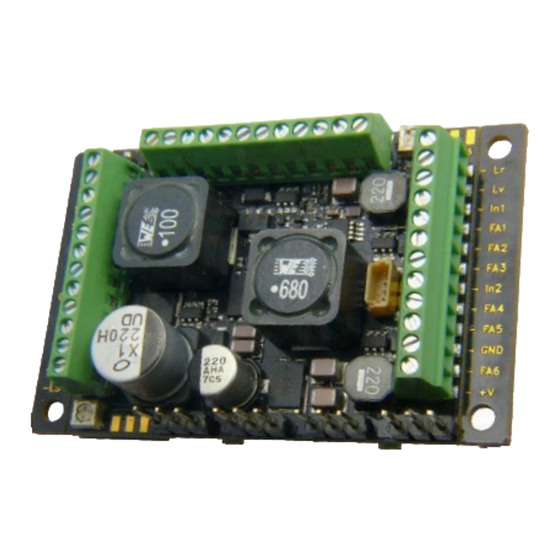Table of Contents
Advertisement
Large-scale Decoder & Sound Decoder MX695, MX696, MX697, MX699
Instruction Manual
LARGE-SCALE DECODER WITH & W/O SOUND
and NON-SOUND LARGE-SCALE DECODER
and: Combinations of loco boards and decoder
and NON-SOUND LARGE-SCALE DECODER
MX695KV, -KS, -LV, LS
MX695KN
MX696V, -S
MX696KS, MX696KV
MX696KN
MX697V, -S
MX699KV, -KS, -LV, -LM
SW-Version 31 --- 2012 08 15
Including the new MX696 decoder --- 2012 11 30
SW-Version 33.0 --- 2013 04 30
with chapter about loco boards --- 2013 05 20
1
Product - Overview .................................................................................................. 2
2
Technical Information ............................................................................................... 4
3
Installation and Wiring ............................................................................................. 5
4
Loco Adapter Boards for Large-Scale Decoder ...................................................... 12
5
Configuration ........................................................................................................ 18
Programming in "Service mode" (on the progr. track) ............................................................. 18
5.1
Programming in "Operations mode" (on-the-main) .................................................................. 18
5.2
5.3
Decoder-ID, Load-Code, Decoder-Type and SW-Version ...................................................... 19
5.4
Engine address(es) in DCC mode ........................................................................................... 19
5.5
Analog operation ...................................................................................................................... 20
5.6
Motor control and regulation .................................................................................................... 21
5.7
Acceleration and Deceleration: ................................................................................................ 24
5.8
The ZIMO "signal controlled speed influence" (HLU) .............................................................. 26
5.9
"Asymmetrical DCC-Signal" stops (Lenz ABC)........................................................................ 26
5.10
5.11
DC Brake Sections (Märklin brake mode) ............................................................................... 27
5.12
Distance Controlled Stopping - Constant Stopping Distance ................................................. 27
5.13
Shunting, Half-Speed and MAN Functions .............................................................................. 28
5.14
The NMRA-DCC function mapping .......................................................................................... 29
5.15
The extended ZIMO Function mapping ................................................................................... 30
"Unilateral Light Suppression" .................................................................................................. 31
5.16
The "Swiss Mapping" (from SW version 32) ............................................................................ 32
5.17
The ZIMO "Input-Mapping" SW versions 34 and up, also for outputs via SUSI ...................... 34
5.18
5.19
Dimming, Low beam and Direction Bits ................................................................................... 34
5.20
Flasher Effect ........................................................................................................................... 35
5.21
F1-Pulse Chains (Only for old LGB products) ......................................................................... 35
5.22
Special Effects (US and other light effects, smoke generator, uncouplers etc.) ..................... 36
5.23
Configuration of smoke generators .......................................................................................... 37
5.24
Configuration of Electric Uncouplers........................................................................................ 38
5.25
Servo Configuration ................................................................................................................. 40
Feedback - Bidirectional communication ............................................................... 41
6
ZIMO SOUND - Selection and Programming ......................................................... 42
7
7.1
7.2
The test run for determining the motor's basic load ................................................................ 46
7.3
7.4
Basic settings independent of powertrain ................................................................................ 47
Steam engine Basic sound settings .................................................................................... 49
7.5
Steam engine Load and acceleration dependency ............................................................. 51
7.6
7.7
Diesel and Electric engines ..................................................................................................... 53
7.8
Random and Switch input sounds ........................................................................................... 56
CV - Summery List ................................................................................................ 57
8
9
Service Insructions................................................................................................. 60
ZIMO decoders contain a microprocessor with appropriate software. The software version can be read out from CV #7 and #65.
The current version may not yet capable of all the functions mentioned in this manual. As with other computer programs, it is also
not possible for the manufacturer to thoroughly test this software with all the possible applications. Installing new software ver-
sions later can add new functions or correct recognized errors. SW updates can be done by the end user for all ZIMO decoders
since production date October 2004, see chapter "Software Update"! Software updates are available at no charge if performed by
the end user (except for the purchase of a programming module); Updates and/or upgrades performed by ZIMO are not consid-
ered a warranty issue and are at the expense of the customer. The warranty covers hardware damage exclusively, provided such
damage is not caused by the user or other equipment connected to the decoder. For update versions, see www.zimo.at.
Page 1
EDITION
2015 06 01
2011 05 01
2015 07 07
2011 08 15
2015 09 23
2018 04 20
2019 05 16
2014 10 12
Advertisement
Table of Contents

















Need help?
Do you have a question about the MX695 and is the answer not in the manual?
Questions and answers